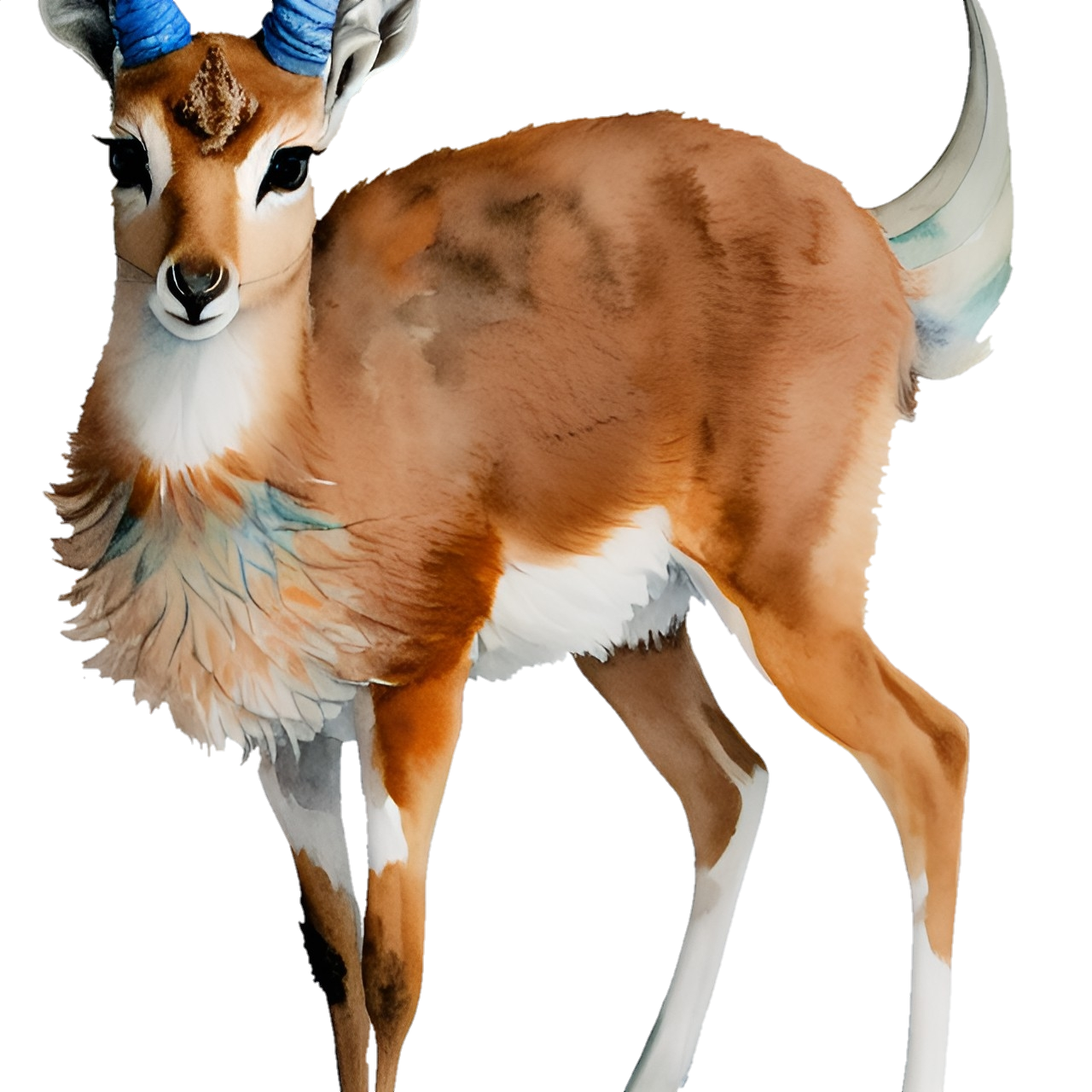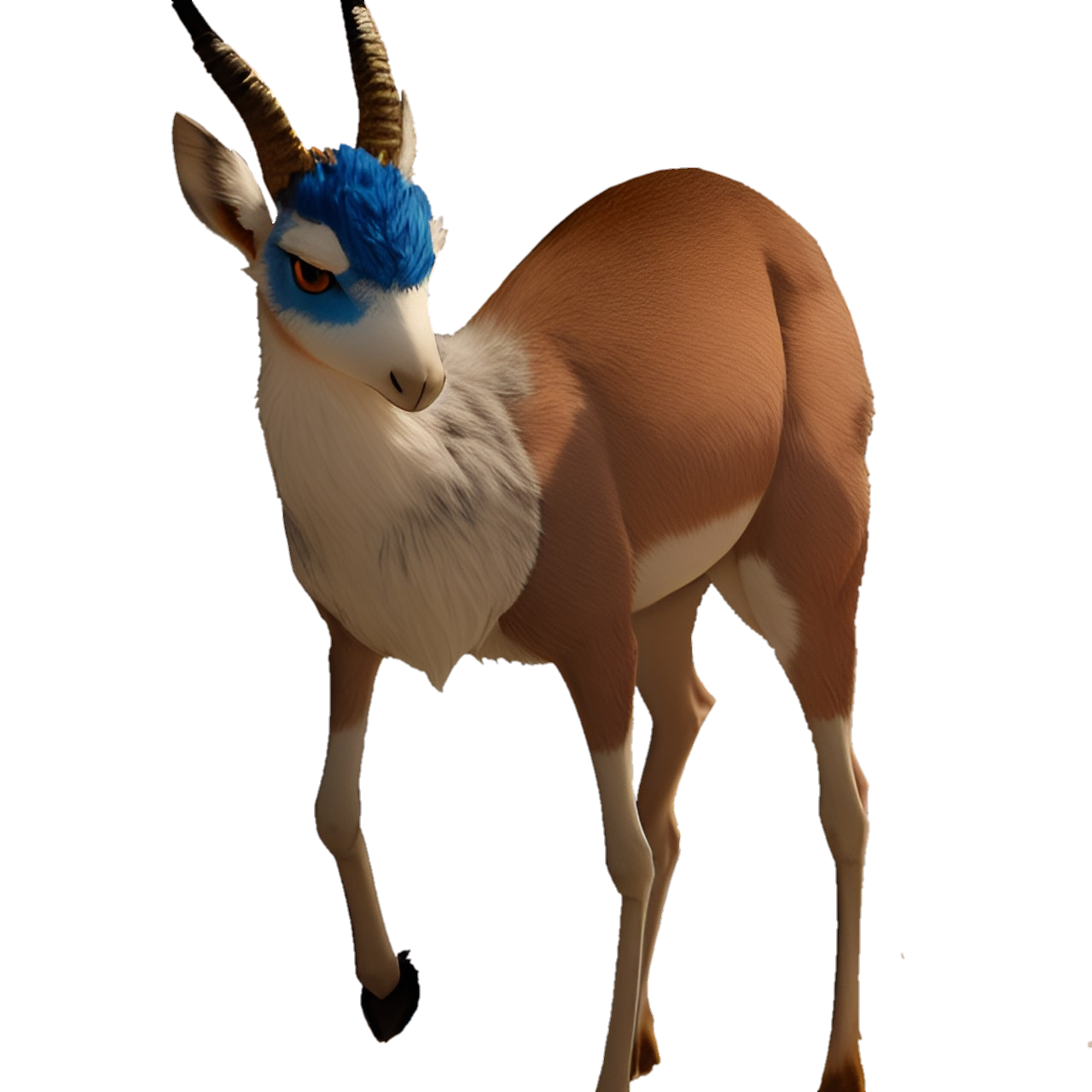Raqs Gazelle
Common to the dunes of Shamsi Desert, the Raqs Gazelle, or Gazhaal al-Raqs in al-'arabiyyah is a small but mobile gazelle. In fact, it is one of the fastest and most agile beasts in Emynea, a favorite creature of Rylis. It is perfectly adapted for life in the radiant dunes, capable going it's whole life without water! It also has a symbiotic relationship with Murna Acacia and they are famous for their tendency to dance to communicate!
These creatures are able to outrun or at least outmaneuver almost any other beast with a mixture of speed and agility. Fliris' Aura or Movement both amplify it's already impressive mobility. Aura manifestations allow it to generate short bursts of flight, decreased gravity or increased speed and agility for themselves and others. Those with auras generally aid their whole herd with this ability. A Movement manifestation is focused solely on their own movements, able to move freely and unhindered by normal physics. Rylis considers these gazelle one of his finest patron animals, darting about the desert freely.
Aside from their array of evolutionary adaptions, their second racial magic allows them to live safely even in the most hazardous regions of the desert. Rithaldis' Shield renders them totally immune to all radiant energy. With this, they travel safely throughout the Dunes without fear of the radiant magic—unbothered by its extreme heat or radiation. It can also eat local plants which protect themselves with radiant magic, many species even relying on them for propagation. Even most predators using radiant magic can only harm them by natural means.
These creatures are able to outrun or at least outmaneuver almost any other beast with a mixture of speed and agility. Fliris' Aura or Movement both amplify it's already impressive mobility. Aura manifestations allow it to generate short bursts of flight, decreased gravity or increased speed and agility for themselves and others. Those with auras generally aid their whole herd with this ability. A Movement manifestation is focused solely on their own movements, able to move freely and unhindered by normal physics. Rylis considers these gazelle one of his finest patron animals, darting about the desert freely.
Aside from their array of evolutionary adaptions, their second racial magic allows them to live safely even in the most hazardous regions of the desert. Rithaldis' Shield renders them totally immune to all radiant energy. With this, they travel safely throughout the Dunes without fear of the radiant magic—unbothered by its extreme heat or radiation. It can also eat local plants which protect themselves with radiant magic, many species even relying on them for propagation. Even most predators using radiant magic can only harm them by natural means.
Racial Magic
First Ability
Rithaldis' Shield
Immune to damage or ill effects from both radiant magic and naturally occurring radiant energy. Thks includes powerful sunlight, solar plasma, photons and radiation.
Second Ability
Fliris' Aura
Able to generate short bursts of flight, decreased gravity, increased speed, velocity or agility and decreases in size for themselves or others.
Fliris' Movement
Able to step, walk or move freely, unhindered by normal physics. Includes increased speed and agility and unearthly, unpredictable motions. Can adjust the velocity and movements of their own body.
Anatomy
Size
Original Ancestor
Dorcas Gazelle
Lifespan
These are one of the smallest species of gazelle on Emynea. Despite this, they are incredibly fast even without magic, attributed to the length of their legs compared to their body size. Both males and females possess their characteristic horns, more pronounced than other species of gazelle. Male horns are 250-280 mm (9.8-11 in) long with 20-24 rings while females are smaller, 170-190 mm (6.7-7.5 in) with 16-18 rings. They have been known to use them for defense or for digging up plant bulbs.
Coloration
Adaptions
These gazelle are capable of running up to 50-60 mph (80-96 km/h) without even using their racial magic, moving at almost imperceptible speeds when utilizing their abilities. Their speed rivals even the Cheetah, one of their predators. When this still isn't enough, they will zig zag with incredible agility and wear their predators out. Often this is the responsibility of the male, one reason females tend to outnumber them. Despite their adaptions, they are flighty and wired by nature, a prime prey in their food web, and have been known to become dangerous when surrounded. They will weaponize their horns and have even been known to kill people.
Raqs Gazelle can go their entire lives without drinking water directly, getting all of the water they need from their diet. They can hold onto their water by doubling the concentration of their urine and releasing less than a quarter of their usual amount of water when they need to. Their metabolisms are also geared toward their hot environment, regulating their body temperature well. They are still far more active at dawn and dusk, when it is most comfortable, but have been known to alter their behavior depending on predation habits.
Raqs Gazelle can go their entire lives without drinking water directly, getting all of the water they need from their diet. They can hold onto their water by doubling the concentration of their urine and releasing less than a quarter of their usual amount of water when they need to. Their metabolisms are also geared toward their hot environment, regulating their body temperature well. They are still far more active at dawn and dusk, when it is most comfortable, but have been known to alter their behavior depending on predation habits.
Senses
This gazelle relies heavily on its sharp eyesight to monitor for predators. They have keen reflexes and their eyes are attuned to motion at a distance. They will alert each other to the presence of a predator in a variety of ways, very communicative to each other. They might shiver, twitch their tails or even bounce and leap in a position called stotting.
Diet
Raqs Gazelle feed on leaves, flowers and pods of various desert species. They have a symbiotic relationship with Murna Acacia, dispersing and germinating their seeds. They will also feed on the leaves, twigs and fruit of various bushes and may even stand on their hind legs to graze on trees if not using their magic to leap through the air and perch on branches
Spotting a herd of tiny gazelle perched on the branches of a Murna Acacia or Mawa Palm is quite the sight, especially if one is spotted and they scatter. They will use their horns after it rains in order to dig up bulbs from the softened soil but their favorite treat are called rain lilies. These are hard to find but are known to summon rain when disturbed. Sudden or unexpected rains are usually attributed to ghazaal grazing on this bloom.
Spotting a herd of tiny gazelle perched on the branches of a Murna Acacia or Mawa Palm is quite the sight, especially if one is spotted and they scatter. They will use their horns after it rains in order to dig up bulbs from the softened soil but their favorite treat are called rain lilies. These are hard to find but are known to summon rain when disturbed. Sudden or unexpected rains are usually attributed to ghazaal grazing on this bloom.
Ecology and Behavior
In times of scarcity Raqs Gazelle will live in pairs but when they can, they prefer to join together into family herds with one adult male, several females and their calves. Sometimes young males will even travel in a bachelor group of four or five. Besides their natural speed, Rylis adores these creatures for their communicative movements. They enjoy wiggling at each other with complex and obscure meanings—they dance in their own language!
Their name actually means "the dancing gazelle", a quirky sight to those lucky enough to witness it. The gazelle have no confusion though, seeming to understand each other well as they wiggle and even twerk at each other. This isn't limited to butt wiggles either. They will also do the same with their tails and horns, leaping and trotting along desert sands, prancing through the air using their magic, their teeny bodies expressing all manner of unspoken chitchat. It may even just be a way to relieve stress, these gazelle always on alert for predators. Vocal calls have an interesting range as well. Their alarm calls sound like short barks, louder and more desperate under extreme stress or pain. Females will grunt to call out their calves and they can even make a long growl when they are annoyed.
Their name actually means "the dancing gazelle", a quirky sight to those lucky enough to witness it. The gazelle have no confusion though, seeming to understand each other well as they wiggle and even twerk at each other. This isn't limited to butt wiggles either. They will also do the same with their tails and horns, leaping and trotting along desert sands, prancing through the air using their magic, their teeny bodies expressing all manner of unspoken chitchat. It may even just be a way to relieve stress, these gazelle always on alert for predators. Vocal calls have an interesting range as well. Their alarm calls sound like short barks, louder and more desperate under extreme stress or pain. Females will grunt to call out their calves and they can even make a long growl when they are annoyed.
Life Cycle
Adult males are very territorial during breeding season, the species polgymous by nature and females usually outnumber males. They will mark their territory with dung piles. However, in difficult seasons where resources are sparse, they will mate and travel in pairs. Females are pregnant for six months, usually birthing one calf but twins occasionally occur.
Newborns are well developed with fur and open eyes, able to stand within its first hour after birth. It will also suckle on its first day. During the first two weeks, the calf will curl up beneath bushes while it's mother grazes somewhere nearby. Finally, the calf will then follow it's mother and start eating solid food. It is fully weaned by three months. Most aren't fully capable of magic until this point, relying on those in their herd with Aura manifestations when pursued or the protection of their father.
Newborns are well developed with fur and open eyes, able to stand within its first hour after birth. It will also suckle on its first day. During the first two weeks, the calf will curl up beneath bushes while it's mother grazes somewhere nearby. Finally, the calf will then follow it's mother and start eating solid food. It is fully weaned by three months. Most aren't fully capable of magic until this point, relying on those in their herd with Aura manifestations when pursued or the protection of their father.
Habitat
Raqs Gazelle are the most adapted gazelle to arid environments. They can live in savannahs, semi-deserts, sand dune fields and wadis. The largest number of them are found in the radiant dunes in northern Alkelbulan where there are fewer predators capable of enduring the intense habitat. Raqs Gazelle are found throughout the Shamsi Desert all the way to Birit Narim, bordering Parsa. They can also be found in small groups within Nyasi za Rangi and Gaarreen Ho'aa.
Predators
Their natural predators are humans, cheetahs, leopards and lions. ǁKo Wild Dog and Manid Hyena will also hunt them on occasion. Serval, caracal and other smaller predators will prey on the calves. Most predators aren't particularly successful, these gazelles extremely evasive.
Human Interaction
The pelts and horns of these gazelles can be found in markets, used decoratively or in medicines. They are otherwise hunted for their meat and Ilnid enjoys keeping them as pets, some of his court imitating him. They remind him of his father and he enjoys showing them off to him when Rylis visits.












Comments